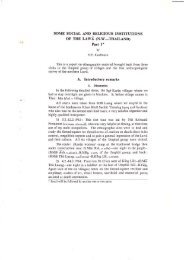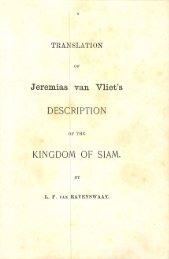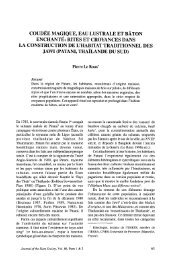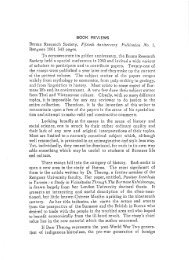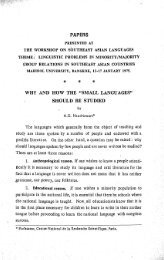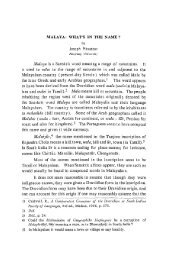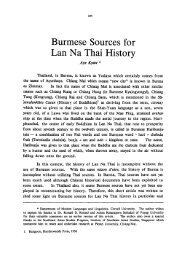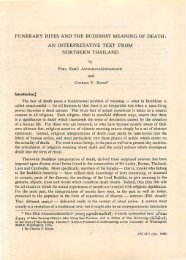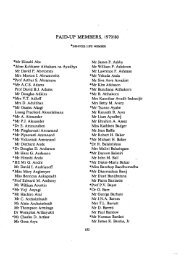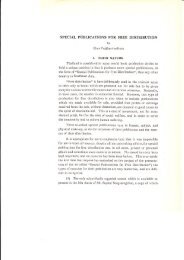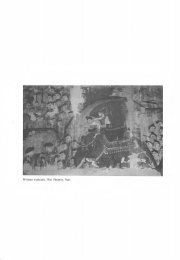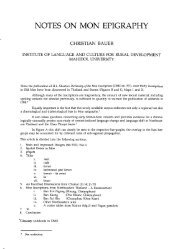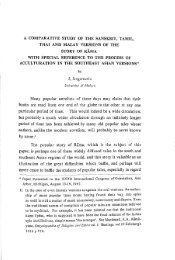REVKJEWS - Siamese Heritage Protection Program
REVKJEWS - Siamese Heritage Protection Program
REVKJEWS - Siamese Heritage Protection Program
You also want an ePaper? Increase the reach of your titles
YUMPU automatically turns print PDFs into web optimized ePapers that Google loves.
184<br />
Michael Smithies<br />
A point of debate is whether the siteran really can be said to belong to the<br />
gamelan, which by definition involves percussive instruments that are struck with a<br />
hammer. The rebab (viol) and suling (flute) were both added under external influences,<br />
but neither the siteran nor the celempung, both zither-type instruments and both<br />
presumably introduced under Chinese influence, belong inherently to the gong-chime<br />
cultures of Southeast Asia. Neither has been heard by this reviewer taking part in a<br />
full gamelan orchestra performance. There might possibly here be some confusion<br />
between Javanese music in general and gamelan music proper.<br />
Nevertheless, Ms. Lindsay writes clearly, reasonably objectively and necessarily<br />
succinctly on an extensive subject which has tremendous cultural remifications within<br />
Javanese society.<br />
The longer though still brief Van Ness-Prawirohardjo volume is chiefly disap<br />
pointing in the poor quality of some of the photographs; the colour plates of the warung,<br />
the street scene, the dalang, golek heads and Arjuna, like the black-and-white photo<br />
graphs of paper wayang and the cempala, are ill-defined, or out of focus, or unintelligi<br />
ble. Whilst it is a good idea to allow a reader to compare the static coloured figure<br />
with the silhouette form it presents on the screen, to repeat with both coloured plates<br />
and black-and-white photos the figures of Kayon, Wayang Prampogan, Arjuna, Bima,<br />
Adipati-Karma and others, separated and without any cross-referencing, either between<br />
plates or to the text, is singularly unhelpful. To include an illustration of a Cambodian<br />
shadow-play figure and a Chinese one from Yogyakarta without any reference to them<br />
in the text indicating why they are there and what they signify is also unhelpful.<br />
Because the wayang culture so profoundly permeates Javanese culture and<br />
affects Javanese attitudes, perhaps it is impossible for any volume, least of all one as<br />
short as this, to do justice to the subject. The book starts by placing the wayang in<br />
the past and the present, elaborates on the epics and important personages in them,<br />
discusses the da lang and his art, and then describes a particular wayang performance.<br />
The introductory chapter does not develop clearly and one has, almost inevitably, a<br />
confused picture of wayang kulit and its relationship to other Javanese theatres. The<br />
most satisfactory section is that dealing with the dalang, though this is confused by the<br />
insertion of descriptions of typical scenes from wayang kulit performances, which have<br />
little directly to do with a description of the dalang's role and functions. The last<br />
chapter, describing a specially-arranged performance at Mrs. Prawirohardjo's family<br />
house, is the least successful. Perhaps here the style of the text is most obviously intru<br />
sive, being on occasions chattily housewifely ('It is amazing how efficiently all the<br />
preparations are realised with no one person really coordinating things'). There is no



